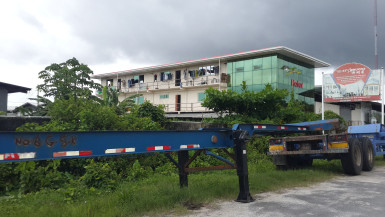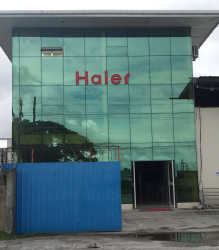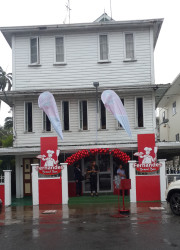Three years after the launch of the Haier Electrical Appliances Ltd plant at Industrial Site, Ruimveldt, which was intended to assemble 200 laptops per day along with televisions, the space is being used for storage.

Brain James, the company’s local representative, told Stabroek News that the ever-changing technology landscape and the high cost of production and energy have stalled the project indefinitely.
James noted that the high-tech development field can be one where by the time you get things off the ground, the world has moved on to the next thing.
Asked whether this would have been known long before Haier proposed opening an assembly plant in Guyana, James said to some extent.
He noted that after the first wave of One Laptop Per Family (OLPF) computers were issued, the then PPP/C government had committed to a second and third wave that never materialised. Under the previous administration, there were numerous complaints that the netbooks issued under the OLPF project, which faced tremendous scrutiny, were shoddily made. Minister of State Joseph Harmon, after a recent tour of the OLPF offices, said he found an inventory of “unserviceable and defective” computers.
The company had been awarded the US$7.56 million contract for the supply of 27,000 netbooks for the OLPF project in 2012. The project has been put under review by the new government.
James noted that without a large-scale contract, such as the OLPF, the costs are too high. He said the opportunity to partake in the production and distribution of thousands of units was the main reason for getting behind the local plant but it never materialised.
 He added that under the contract, the standards and the goal posts kept changing. He emphasised that purchasing power in Guyana was limited
He added that under the contract, the standards and the goal posts kept changing. He emphasised that purchasing power in Guyana was limited

due to the high cost of production and energy and as a result the plant was delayed multiple times.
He also said the company was in talks to switch from the assembly of laptops to tablets but noted that more needs to be addressed before this would be feasible. He said too there is interest in photovoltaics, which involves converting solar energy into direct current electricity.
At the launch of the company’s operations in June, 2012, James had said then that the US$2M investment by Haier was a demonstration of its faith in the business environment here and that it would bring foreign exchange into the country. He had also said it would give an indication to the world that Guyana can compete globally in terms of technology.
Earlier, James had told Stabroek News that the company would set up the plant for computers here and also planned to establish an industrial park within five years in an investment pegged at US$10 million.
The first floor was to include a showroom of Haier products assembled there. The ground floor has long been converted into a showroom and assembly space, but not for Haier.
The building itself is in use as it is owned by Jason Wang, proprietor of China Trading. However, Haier is still occupying the upper level of the building.
Stabroek News understands that as far as the assembly line that was launched in June of 2012, it is not in any working order as nothing substantial was ever done.
Local businessman Brian Yong, who has been attached to Haier, uses the space for storage. Stabroek News reached out to Yong for comment and was told that he did not wish to speak to this publication.
Yong recently partnered with Surinamese company Fernandes Bread Box to open a location at the Haier warranty service centre at Middle Street. The lease of the property was transferred to Yong from Haier.
When Stabroek News had visited the bakery, Haier televisions as well as the furniture and the layout were still visible throughout the building.
The assembly plant is not Haier’s first standstill project on the continent. In 2010, Haier agreed to build a US$912M factory for home appliances in Venezuela. Since then, the plant was constructed using a US$800M loan from China and has yet to make a single appliance. All the while, Venezuelan department stores are flooded with Haier appliances imported from China that are paid for through a 2007 loans for oil deal.







